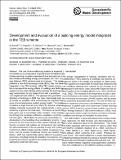Development and evaluation of a building energy model integrated in the TEB scheme
Author(s)
Bueno Unzeta, Bruno; Pigeon, G.; Norford, Leslie Keith; Zibouche, K.; Marchadier, C.
DownloadBueno-2012-Development and eval.pdf (1.908Mb)
PUBLISHER_CC
Publisher with Creative Commons License
Creative Commons Attribution
Terms of use
Metadata
Show full item recordAbstract
The use of air-conditioning systems is expected to increase as a consequence of global-scale and urban-scale climate warming. In order to represent future scenarios of urban climate and building energy consumption, the Town Energy Balance (TEB) scheme must be improved. This paper presents a new building energy model (BEM) that has been integrated in the TEB scheme. BEM-TEB makes it possible to represent the energy effects of buildings and building systems on the urban climate and to estimate the building energy consumption at city scale (~10 km) with a resolution of a neighbourhood (~100 m). The physical and geometric definition of buildings in BEM has been intentionally kept as simple as possible, while maintaining the required features of a comprehensive building energy model. The model considers a single thermal zone, where the thermal inertia of building materials associated with multiple levels is represented by a generic thermal mass. The model accounts for heat gains due to transmitted solar radiation, heat conduction through the enclosure, infiltration, ventilation, and internal heat gains. BEM allows for previously unavailable sophistication in the modelling of air-conditioning systems. It accounts for the dependence of the system capacity and efficiency on indoor and outdoor air temperatures and solves the dehumidification of the air passing through the system. Furthermore, BEM includes specific models for passive systems, such as window shadowing devices and natural ventilation. BEM has satisfactorily passed different evaluation processes, including testing its modelling assumptions, verifying that the chosen equations are solved correctly, and validating the model with field data.
Date issued
2012-03Department
Massachusetts Institute of Technology. Department of ArchitectureJournal
Geoscientific Model Development
Publisher
Copernicus GmbH
Citation
Bueno, B. et al. “Development and Evaluation of a Building Energy Model Integrated in the TEB Scheme.” Geoscientific Model Development 5.2 (2012): 433–448.
Version: Final published version
ISSN
1991-9603
1991-959X